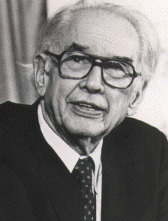 John Vincent Atanasoff (October 1903 – June 1995) [BSE 1925] created and built the first electronic calculating machine. Atanasoff is one of the most distinguished alumni of the College of Engineering and was so recognized with an honorary doctorate of science degree from UF in 1974. He graduated from the University of Florida in 1925 with a BS degree in electrical engineering.
John Vincent Atanasoff (October 1903 – June 1995) [BSE 1925] created and built the first electronic calculating machine. Atanasoff is one of the most distinguished alumni of the College of Engineering and was so recognized with an honorary doctorate of science degree from UF in 1974. He graduated from the University of Florida in 1925 with a BS degree in electrical engineering.
In the late 1930s, Atanasoff sought a way to facilitate linear algebraic calculations needed for his research. In 1939, he created a prototype of the first digital calculator, which possessed many features of modern computers – a binary system, regenerative memory, logical schemes as elements of software, and electronic components for storing data. The prototype, built with his student, Clifford Berry, was finished in 1942. The concepts were borrowed, without permission, to build ENIAC in the 1940s. A 1973 lawsuit established that Atanasoff was indeed the father of the digital computer. That fact has gone largely unrecognized, in spite of the ruling of a federal judge that established Atanasoff’s original contribution to the computer age and declared his right to be noted by his colleagues and in history as “the inventor of the computer.”
Atanasoff was born in Hamilton, NY. His father, John, came to the U.S. from Bulgaria in 1889. He, too, was an electrical engineer. His mother, Iva Purdy, taught mathematics. The family moved to Osteen, Florida, in 1912 and lived with Atanasoff’s uncle who was Justice of the Peace of Sanford. Atanasoff started public school in 1913 in a two-room schoolhouse. He learned to use the slide rule and studied logarithms when he was only nine years old.
Atanasoff finished high school in 1920 and worked during the summer as a prospector for a phosphate mine for $3 to $4 a day to save money to attend UF. He saved about $500, but the money ran out shortly after his first year at UF. He began working odd jobs to make ends meet. At that point, he met Fritz Buchholz, Alachua County public school superintendent. Buchholz was looking for someone to teach high school science and asked Atanasoff to lead the science department. Atanasoff, then in his junior year in engineering, would first have to pass the state exam in physics, agriculture, and biology. Atanasoff studied for three days and passed the tests with flying colors. At the age of 20, he became head of the science department for public schools in Gainesville.
During his time at UF, Atanasoff was quite active in a number of campus organizations. He was a member of Sigma Tau, Phi Kappa Phi, the Polk County Club, and the Benton Engineering Society, which he served as both vice president and president. Atanasoff was particularly fond of Dr. John R. Benton, the College of Engineering’s first dean, and Benton always encouraged Atanasoff to persevere with his inventions. It was just such encouragement that kept Atanasoff experimenting with new ideas.
After graduating with his BS degree, Atanasoff began graduate work in mathematics and theoretical physics at Iowa State University and received his MS degree in 1926. He then went to the University of Wisconsin where he obtained his Ph.D. in 1930. He later returned to Iowa State where he had a distinguished teaching career. It was also at Iowa State where Atanasoff and his graduate student, Clifford Berry, first began work on the ABC (Atanasoff-Berry Computer) in the basement of the physics building. The ABC would become the subject of a lengthy patent trial almost 30 years after the prototype was built. The suit was initiated by Sperry Rand Corporation, holder of the ENIAC patent assigned to its inventors John Mauchly and J. Prespert Eckert, when Honeywell challenged the royalties it had been paying Sperry Rand for the ENIAC. In 1973, Judge Earl Larsen concluded that the builders of the ENIAC, long considered the first computer, “did not themselves first invent the automatic digital computer, but instead derived the subject matter from one Dr. John Vincent Atanasoff.” Atanasoff never received any financial compensation or royalties from the outcome of the patent suit.
Atanasoff left Iowa State University at the start of World War II. He held various positions in the U.S. Naval Ordnance Laboratory and several other military programs. He received the Navy’s highest civilian honor, the Distinguished Service Award, for his work. He started his own corporation, the Ordnance Engineering Company, following the war. He later sold the company to the Aerojet General Corporation and stayed on as its vice president until he retired in 1961. Atanasoff received the National Medal of Science and Technology in 1990. He died June 15, 1995 of a stroke at his home in Monrovia, MD. He was 91 years old. Atanasoff has had a tremendous, if not well known, impact on the development of the computer and the course of history-the magnitude of which can probably never be fully measured.
Writer: Patricia Morris Edited by: Patricia Casey and Laurie Edvardsson
